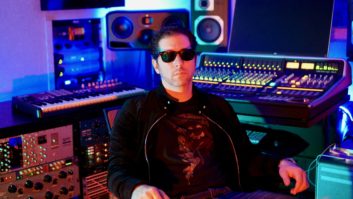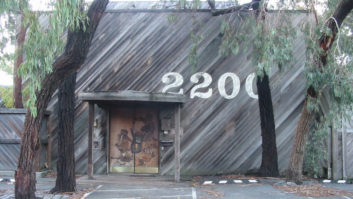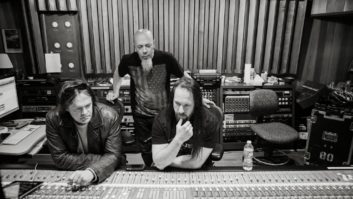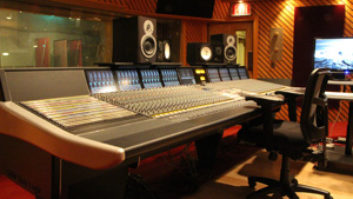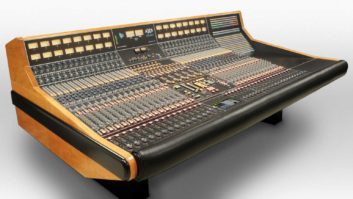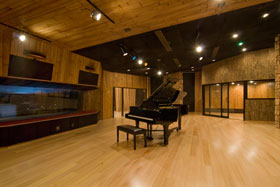
Fantasy Studio D now offers a new cherry hardwood floor, and its isolation booth received newly installed glass and a sliding door.
Photo: Kyle Hixson
Succeeding as a top-flight, multi-room commercial production facility over a span of four decades is certainly no small feat. But Fantasy Studios in Berkeley, Calif., has, continually distinguishing itself as a model of resilience, innovation and vitality. Now 40 years in, Fantasy is thriving as an independently run facility, celebrating with a complete physical upgrade of Studio D, which was originally designed by Tom Hidley, by installing new cherry hardwood floors and creating a new glass isolation booth. The celebrations continue into 2012 as staff members have been busy serving clients in the music, film, television, and videogame industries, who fill Fantasy’s storied rooms week after week.
The name Fantasy Studios evokes its proud legacy as the launching pad for a vast number of historically important album projects. The studios opened in February 1971 as the in-house recording, mixing and mastering facility for Saul Zaentz’s Fantasy Records label, hosting label stars Creedence Clearwater Revival and jazz and blues icons such as Bill Evans, Herbie Hancock, Sonny Rollins, Chick Corea, Tony Bennett, and BB King. Zaentz’s label and studio business grew rapidly in the 1970s as the facility added film and TV post-production (One Flew Over the Cuckoo’s Nest, Amadeus) and attracted major recording artists from around the world. Over the ensuing decades, Fantasy built an impressive client list that includes the Grateful Dead, Aerosmith, Santana, Journey, Green Day and En Vogue, on up to Lil Wayne and Joanna Newsom, to name but a very few.
Still, the past few years have perhaps been Fantasy’s most challenging. Following Zaentz’s sale of the label, studio assets and catalog to Concord Records in 2004, Zaentz sold his seven-story building in 2007 to real estate developer Wareham Development, and Concord relocated its label and catalog to Beverly Hills. This created a perception among many in the industry that Fantasy would close, or had closed.
Far from it. Wareham purchased Fantasy’s equipment from Concord and named Jeffrey Wood, a veteran producer/engineer who has worked steadily at the studios since 1995, as its new Studio Director. “They have been trusting the vision, being very supportive,” Wood affirms. “The whole building was renovated when [Wareham] took over. We have all-new carpets, ceilings and lighting. They rebuilt the whole lobby. It was symbolic of their wish to open [Fantasy] up to the community and make it a creative hub for every style of music. We work with new bands and new artists all the time, and every session gets the same care from our engineers and staff.”
ROOM UPGRADES
Wood cites a number of physical upgrades to Fantasy’s three rooms—Studios A, B and D—over the past four years, starting with new acoustic wall fabric for Studio A. “We’ve spent a lot of time, energy and money on maintenance, and that continues to this day,” he says. “We put in a brand new cherry hardwood floor in Studio D, which has changed the sound in the most positive way. It’s a more focused sound [than Studio A] because [D] has a lower ceiling. However, it breathes. It’s got life to it.” Fantasy also enclosed its Studio D isolation booth in glass, installing a sliding-glass door, which Wood says expanded the usage of the room. “Now you can put drum kits, the piano [and] string sections anywhere. And we can [accommodate] large amounts of people: We [hosted] a 50-piece hip-hop orchestra and we can do that live because we have the space, the mics, the headphones.”
Wood notes that the changes made to Studio D add up to “big changes for Fantasy, because previously we were trying to always honor the sound of the rooms. These were decisions we didn’t take lightly. I got a full all-systems-go on all the changes from everybody we spoke with. The way the flooring was put in was honoring the floating floor underneath, a series of plywood build-ups with high-quality plywood with no gaps so that there are no resonance issues.”

Studio A, which features a 9-foot Yamaha CF concert grand piano, received new high-quality sonic fabric while retaining its characteristic sound
Photo: Steve Maruta
In Studio B, which features a 21×26-foot live room, Wood swapped the 14×18-foot control room’s Trident 80B analog console for an Avid C24. “We totally rewired Studio B when we put in a control surface,” he says, “and we rewired the patchbay entirely—took up the flooring, ran all-new wiring under the floor, and rewired it for 5.1 surround.” Wood notes that it is possible to gain access to Fantasy’s five (of its original eight) echo chambers from any control room. “All rooms are connected by central patch so that you can have somebody down in B and be recording in D. The modifications we’ve made within the rooms always work with those systems.”
Notably, in 2011 Fantasy re-instituted Foley by commissioning four mobile Foley pits—wooden boxes with concrete bottoms built to industry-standard specifications that can be used in any room. Wood explains that Fantasy’s dedicated Foley room, Studio C, “is closed for renovation because we’re chipping away at it.” Recent post projects include Moneyball, Happy Feet 2 and the March 9 Pixar release John Carter.
All of Fantasy’s rooms are equipped with Pro Tools HD systems, Studer analog tape machines, and high-end microphones and outboard gear. Additionally, they are ISDN-compatible for connecting with studios around the world.

Fantasy Studios’ full-time staff pictured in the Studio A control room. Back row, from left: Jeffrey Wood (Studio Director), Allison Gomer (Assistant Studio Manager), James Gangwer (Chief Technical Engineer), and Alberto Hernandez (Staff Engineer). Front row: Adam Muñoz (Staff Engineer) and Jesse Nichols (Staff Engineer).
Photo: Steve Maruta
INVESTING IN PEOPLE
Beyond Wareham’s improvements to the property’s aesthetic appeal and functionality, Fantasy Studios believes in the importance of its employees and their expertise. “Everything here has been a team effort, and we have a great team,” Wood says. “We’re one of the few studios in Northern California that have hired staff engineers with full benefits, and we try to pay very respectfully. The love of music is why we’re all here.”
Fantasy’s six full-time staff includes Wood; assistant studio manager Allison Gomer; engineers Jesse Nichols, Adam Muñoz and Alberto Hernandez; and chief technical engineer James Gangwer. Veteran mastering engineers George Horn and James Tarantino continue to work in their own rooms as independent contractors. “They’re both legendary in the amount of catalog that they’ve done,” Wood says of Horn and Tarantino. “We do all their transfer work for them and turn clients their way.”
Fantasy also offers an intern program that trains selected audio students to perform vital roles in the studios’ day-to-day operation. “We work with a half-dozen schools across the country,” Wood says. “We have a rigorous interview process because we’re trying to maintain the highest level of professionalism. It’s not only what you’ve learned in class; there are so many other aspects. This is an entry-level learning experience. When people show promise within the program, we do move them into setup and teardown, and then on to assistantship.”
TO THE FUTURE
Reaching beyond its established services and focuses, Fantasy offers its facilities for a variety of purposes, including Webcasts, film and video projects, private concerts and receptions, and more. “We’re getting into visual production, whether it’s televised or streamed,” Wood says. “We’ve been streaming some recording sessions from our rooms with certain name acts that are in. We’ve also been involved with shooting our own television productions. We were involved last year with shooting a pilot for a major cable station on creativity in the recording studio. We’re also involved with a series for PBS that’s coming out, producing content in conjunction with a video production company in the building. We’re trying to think bigger than just being a studio. We’re in the content business. Delivery systems will come and go, but the content always needs to be developed.”
